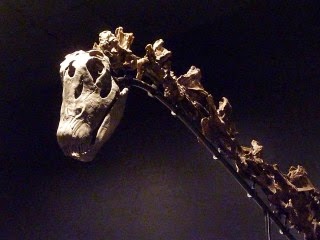Garry and I spent our final morning in Yellowstone Park exploring the Upper Geyser Basin. Unfortunately none of its most impressive formations were scheduled to erupt. Instead we had to content ourselves with a selection of steaming mounds. However, some of the sinter cones we saw were several metres high and the actual geyser's throat frighteningly large. They must present some awesome geothermal displays when they're active.
As we completed our morning stroll we were lucky enough to see Old Faithful erupt one final time. That's a total of seven eruptions for me.
Our route towards Bozeman took us through the spectacular Gallatin River valley. The road wound its way through some stunning gorges and wonderfully unspoilt landscape. We eventually reached Bozeman mid-afternoon where we made a very satisfying stop at the Museum of the Rockies.
The museum houses some of the world's rarer dinosaur fossils. It also sits on a state university campus where many of these discoveries are researched and catalogued. As a result, the museum includes bleeding edge insights on the life and nature of dinosaurs. It's ideally located as the surrounding region is considerable a scientific lodestone of fossils.
Perhaps one of the university's most extraordinary discoveries was a fossil that actually included preserved tissues and blood vessels. This one discovery has turned established theories about fossilization completely on its head. Normally, no natural tissue remains once fossilization occurs. After millions of years of burial we didn't it was possible for these biological artifacts to survive.
The museum also has a fascinating display of skulls from the same dinosaur species at different stages of development. A row of fossils from juvenile to mature adult show how the skull grows over time before its cranial plates fuse (much as the human skull does). The line up is very cool. As is the largest T-Rx skull ever found.
As we completed our morning stroll we were lucky enough to see Old Faithful erupt one final time. That's a total of seven eruptions for me.
Our route towards Bozeman took us through the spectacular Gallatin River valley. The road wound its way through some stunning gorges and wonderfully unspoilt landscape. We eventually reached Bozeman mid-afternoon where we made a very satisfying stop at the Museum of the Rockies.
The museum houses some of the world's rarer dinosaur fossils. It also sits on a state university campus where many of these discoveries are researched and catalogued. As a result, the museum includes bleeding edge insights on the life and nature of dinosaurs. It's ideally located as the surrounding region is considerable a scientific lodestone of fossils.
Perhaps one of the university's most extraordinary discoveries was a fossil that actually included preserved tissues and blood vessels. This one discovery has turned established theories about fossilization completely on its head. Normally, no natural tissue remains once fossilization occurs. After millions of years of burial we didn't it was possible for these biological artifacts to survive.
The museum also has a fascinating display of skulls from the same dinosaur species at different stages of development. A row of fossils from juvenile to mature adult show how the skull grows over time before its cranial plates fuse (much as the human skull does). The line up is very cool. As is the largest T-Rx skull ever found.













No comments:
Post a Comment